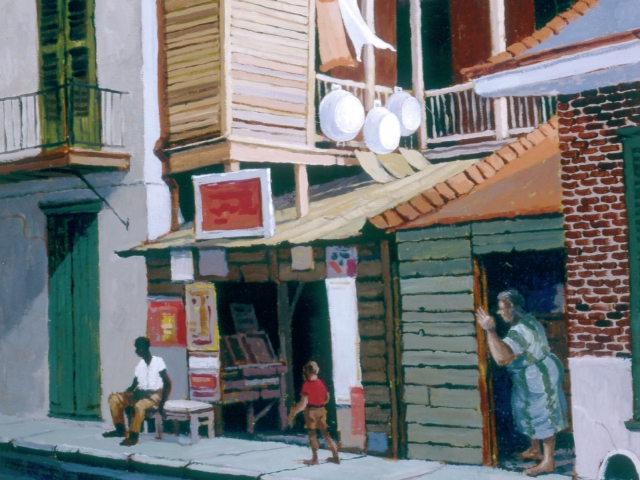

The 1940's were a turning point in married women's labor-force participation, leading many to credit World War II with spurring economic and social change. This paper uses two retrospective surveys, from 1944 and 1951, to show that half of all married women employed in 1950 were working in 1940, and more than half of the decade's new entrants joined after the war. Of all wartime entrants, the majority exited after 1944 but before 1950. The war had several significant indirect impacts on women's employment, but its direct influence appears to have been more modest.
 Dauphine Street; 1963; acrylic on cardboard by Rolland Golden (1931–2019); gift of Rolland Harve Golden, given in memory of Edith Long, 1997.64
Dauphine Street; 1963; acrylic on cardboard by Rolland Golden (1931–2019); gift of Rolland Harve Golden, given in memory of Edith Long, 1997.64
“Don’t you just love these long rainy afternoons in New Orleans when an hour isn’t just an hour—but a little piece of eternity dropped into your hands—and who knows what to do with it?”—Blanche Dubois, in A Streetcar Named Desire by Tennessee Williams
For more than 150 years, artists from around the world have worked to capture and share their impressions of New Orleans’s most iconic and historic neighborhood. This exhibition gathers 22 paintings from the museum’s permanent collection, including intended gifts from Louisiana art collector Laura Simon Nelson. From the bustle of the French Market to the jazzmen of Preservation Hall, these artworks explore the streets, buildings, and people of the French Quarter through time and a variety of techniques.
To enjoy the virtual exhibit, click HERE.
Although the second wave of immigration was a trickle by the 1940s, there were more immigrants than ever in New Orleans. The places immigrants settled were dictated by shifting physical and social geographies, conjunctures of the past, and the unique qualities of New Orleans. The distribution of settlers also reflected old settlement patterns as well as transformations the city underwent with growth.
Settlement was not random: it hinged on finding places that were available, affordable, and near jobs. In the 1800s, immigrants settled in undesirable locations with the most environmental nuisances, the semi-rural peripheries. The peripheries offered the best housing and low skill employment, advantages that outweighed the undesirable characteristics of these locations. As immigrants put down roots, they established social and religious institutions and drew in more immigrants via those networks.
During the early 1900s, industrialization and the rise of centralized business districts transformed New Orleans. New streetcar networks gave the inner city upper class the means to easily move in and out of the city. Because they could afford to leave, they fled to the periphery, which was the most desirable area to live after A. Baldwin Wood designed a drainage system that eliminated swampland hazards and created more usable land. They left many nice town homes in the middle of the city. At the same time, unskilled jobs moved from the periphery to the core of the city, and immigrants began to move into the abandoned town homes, forming what would be called the "Immigrant Belt".
The ethnic and racial history of New Orleans also dictated settlement patterns. As the city grew, Anglos settled in the upper periphery, and Creoles settled in the lower periphery, closer to the unskilled labor and cheap land. The Catholic tradition and festival ambience of lower New Orleans attracted many immigrants from the Caribbean, Latin America, France, Italy, and Eastern Europe. Jews, Scandinavians, and emancipated African Americans typically settled on the Anglo side. This divide was perpetuated as immigrants moved into the inner city.
New Orleans mirrored national trends of urbanization and also strayed from them. It was like many cities of the time in that it expanded, filled with immigrants, and experienced clumped settling patterns. Although people tended to gravitate towards others of their same ethnicity, New Orleans was unique in that it remained very intermixed and multicultural. Its reputation of being more accepting and diverse drew immigrants in and made New Orleans one of the oldest multicultural cities in the nation.
Citations
Ethnic Clusters, 1940, 1940, in From Geographies of New Orleans: Urban Fabrics Before the Storm, ed. Campanella, Richard (LA: Center for Louisiana Studies, 2006), 376.
Campanella, Richard, Geographies of New Orleans:Urban Fabrics Before the Storm (LA: Center for Louisiana Studies, 2006), 300-400.
Campanella, Richard, "Ethnic Geography of New Orleans," Journal of American History Vol. 94 No. 3 (December 2007): 190-200, 370-390.
Lewis, Peirce F., New Orleans: The Making of an Urban Landscape (NM: University of Virginia Press, 2003), 45, 62-70.
Souther, Mark, New Orleans on Parade (LA: Louisiana State University, 2006), 22.